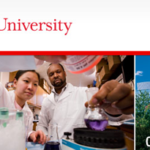By Victoria Razzi — Syracuse University
The College Fix, 7/1/15 — An 80-year-old Duke University professor recently argued that Asian Americans have integrated into America better than African Americans, a controversial and contentious assertion that caused uproar and prompted the scholar to be labeled a racist.
The political science Professor Jerry Hough had posted his controversial statements in mid-May in the comments section of a New York Times editorial headlined “How Racism Doomed Baltimore.”
His comments spurred massive backlash, and even Hough’s own university called them “noxious, offensive … [with] no place in civil discourse.”
However, the question of whether his argument is true remains, with Hough saying: “The point I was raising was why the Asians who were oppressed did so well and are integrating so well, and the blacks are not doing as well.”
With that, The College Fix repeatedly emailed more than 30 Asian American studies professors across America throughout June to get their take on the matter.
The response? Silence.
Educators contacted included scholars at UC Berkeley, UConn, Cornell, Stanford, and UCLA. Out of all of those emailed, only one response was received from Professor Thomas Chen of Tufts University. While he did say that “this professor’s opinions are misguided and misinformed,” he did not provide deeper reasoning as to why.
In a way, the overall silence of some 30 professors speaks louder than words.
Typically, if someone is an expert in a certain field and another person makes an uneducated or false statement, it would be very simple for them to rebut the argument. However, in this case, dozens of professors chose not to publicly reject the claims made by the Duke professor.
A very plausible cause for the silence could be that while the way in which the professor from Duke stated his claims was brash, the basis of his accusations hold some truth.
Asian Americans, the so-called “model minorities” – have faced their own struggles, including street gangs, poverty, and employment and college admissions discrimination. What’s more – many Asian American families and neighborhoods retain their own cultures, so perhaps they don’t “integrate” into America as much as capitalize on the country’s economic opportunities.
But certainly, Asian Americans have faced segregation in their past.
“Though it’s little known, [Asian-American and Pacific Islander students in the U.S.] are no strangers to segregation—and even outright exclusion—from schools attended by White students,” the National Education Association reported in May 2008. “Indeed, during the nineteenth century, the debate was not whether API children should attend integrated schools, but any school at all.”
Yet the NEA went on to report that today, Asian-American and Pacific Islander students “are the most integrated ethnic group” – while they still face hurdles. “API students are acutely susceptible to experiencing cultural and linguistic isolation in America’s schools,” the association reported.
A 2012 Pew Research Center report titled “The Rise of Asian Americans” stated that “Asian Americans are the highest-income, best-educated and fastest-growing racial group in the United States. They are more satisfied than the general public with their lives, finances and the direction of the country, and they place more value than other Americans do on marriage, parenthood, hard work and career success, according to a comprehensive new nationwide survey by the Pew Research Center.”
“A century ago, most Asian Americans were low-skilled, low-wage laborers crowded into ethnic enclaves and targets of official discrimination,” the center reports. “Today they are the most likely of any major racial or ethnic group in America to live in mixed neighborhoods and to marry across racial lines.”
“These milestones of economic success and social assimilation have come to a group that is still majority immigrant,” the center added. “Nearly three-quarters (74%) of Asian-American adults were born abroad; of these, about half say they speak English very well and half say they don’t.”
Circling back to Hough, the controversy surrounding his assertions started back in May, after the New York Times published an editorial titled “How Racism Doomed Baltimore” that suggested segregation polices of decades ago in the city created poverty in the region and ultimately led to the massive riots that took place last month in the wake of the death of Freddie Gray.
The New York Times cited a study from Harvard University that suggested Baltimore is “perhaps the worst large city in the country when measured by a child’s chances of escaping poverty.” The editorial goes on to discuss how, when placed in context of the city’s history regarding racism, “the facts make perfect sense.”
“The data showing diminished life chances for poor people living in Baltimore should not be startling,” the Times wrote. “The tensions associated with segregation and concentrated poverty place many cities at risk of unrest. But the acute nature of segregation in Baltimore — and the tools that were developed to enforce it over such a long period of time — have left an indelible mark and given that city a singular place in the country’s racial history.”
In response, Hough argued in the comments section of the editorial that African Americans have spent far too much time “feeling sorry for themselves” whereas Asian Americans have just worked hard.
The professor went on to discuss how Asian Americans have further assimilated themselves through namesake and marriage. He wrote:
“This editorial is what is wrong. The Democrats are an alliance of Westchester and Harlem, of Montgomery County and intercity Baltimore. Westchester and Montgomery get a Citigroup asset stimulus policy that triples the market. The blacks get a decline in wages after inflation.
But the blacks get symbolic recognition in an utterly incompetent mayor who handled this so badly from beginning to end that her resignation would be demanded if she were white.The blacks get awful editorials like this that tell them to feel sorry for themselves.
In 1965 the Asians were discriminated against as least as badly as blacks. That was reflected in the word “colored.” The racism against what even Eleanor Roosevelt called the yellow races was at least as bad. So where are the editorials that say racism doomed the Asian-Americans. They didn’t feel sorry for themselves, but worked doubly hard.
I am a professor at Duke University. Every Asian student has a very simple old American first name that symbolizes their desire for integration. Virtually every black has a strange new name that symbolizes their lack of desire for integration. The amount of Asian-white dating is enormous and so surely will be the intermarriage. Black-white dating is almost non-existent because of the ostracism by blacks of anyone who dates a white.
It was appropriate that a Chinese design won the competition for the Martin Luther King state. King helped them overcome. The blacks followed Malcolm X.”
Hough has stated he plans to write a book on the subject of Asian integration versus black integration.











